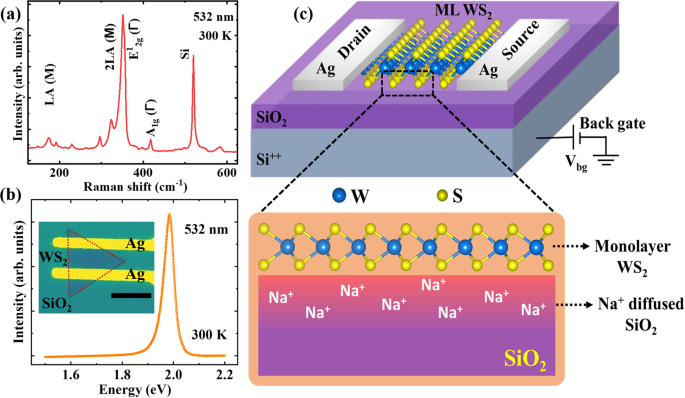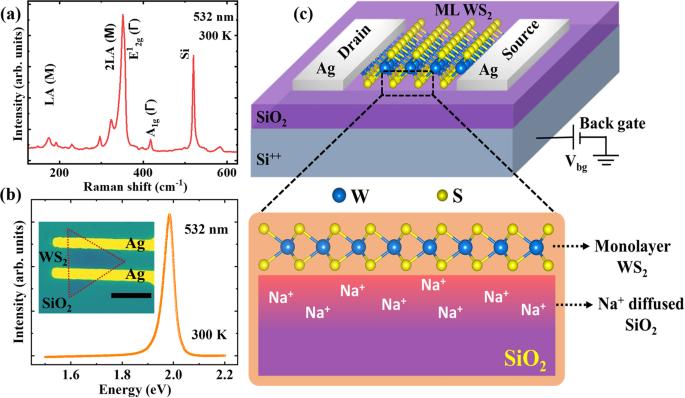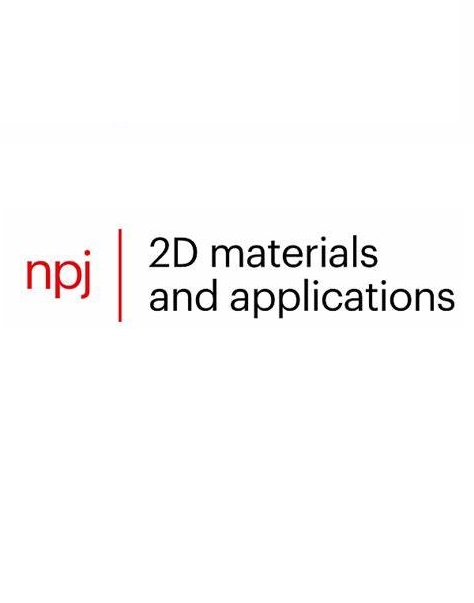用于 6 位存储和神经形态高温适应的 Ionotronic WS2 晶体管
IF 8.8
2区 材料科学
Q1 MATERIALS SCIENCE, MULTIDISCIPLINARY
引用次数: 0
摘要
受大规模并行性、物联网设备的增加、稳健计算和大数据的启发,利用不同材料、机制和最先进架构构建多位忆晶体管的研究日益增多。在此,我们展示了基于单层 WS2 的功能性忆晶体管器件,该器件可在高温下实现非挥发性和突触操作。基于 WS2 的离子电子存储器件表现出反向滞后,存储器窗口大于 25 V,消光比大于 106。除了 6 位(64 个不同的非易失性存储级别)脉冲可编程存储器功能之外,这种存储器晶体管还具有超过 100 个扫描周期和 400 个脉冲周期的稳定保持和耐久性,其电流幅度超过 6 个数量级(10-12-10-6 A)。多位态的起源归因于移动离子诱导的静电掺杂波动下的载流子动力学,并通过使用包括带弯曲图片在内的指纹机制加以说明。通过获得可靠的信噪比,证实了所有存储状态的可信度。我们还展示了关键的神经形态行为,如突触可塑性、近线性电位和抑制,使其适合在高温神经形态计算中成功实现。此外,我们还根据拟议离子晶体管的电导权重更新特性进行了人工神经网络模拟,以探索其在准确图像识别方面的潜力。我们的研究成果展示了基于二维半导体的另一类热辅助存储器,为要求苛刻的电子设备和即将到来的神经形态计算技术中的高温存储器应用开辟了一条大有可为的途径。本文章由计算机程序翻译,如有差异,请以英文原文为准。


Ionotronic WS2 memtransistors for 6-bit storage and neuromorphic adaptation at high temperature
Inspired by massive parallelism, an increase in internet-of-things devices, robust computation, and Big-data, the upsurge research in building multi-bit mem-transistors is ever-augmenting with different materials, mechanisms, and state-of-the-art architectures. Herein, we demonstrate monolayer WS2-based functional mem-transistor devices which address nonvolatility and synaptic operations at high temperature. The ionotronic memory devices based on WS2 exhibit reverse hysteresis with memory windows larger than 25 V, and extinction ratio greater than 106. The mem-transistors show stable retention and endurance greater than 100 sweep cycles and 400 pulse cycles in addition to 6-bit (64 distinct nonvolatile storage levels) pulse-programmable memory features ranging over six orders of current magnitudes (10−12–10−6 A). The origin of the multi-bit states is attributed to the carrier dynamics under electrostatic doping fluctuations induced by mobile ions, which is illustrated by employing a fingerprint mechanism including band-bending pictures. The credibility of all the storage states is confirmed by obtaining reliable signal-to-noise ratios. We also demonstrate key neuromorphic behaviors, such as synaptic plasticity, near linear potentiation, and depression, rendering it suitable for successful implementation in high temperature neuromorphic computing. Furthermore, artificial neural network simulations based on the conductance weight update characteristics of the proposed ionotronic mem-transistors are performed to explore the potency for accurate image recognition. Our findings showcase a different class of thermally aided memories based on 2D semiconductors unlocking promising avenues for high temperature memory applications in demanding electronics and forthcoming neuromorphic computing technologies.
求助全文
通过发布文献求助,成功后即可免费获取论文全文。
去求助
来源期刊

npj 2D Materials and Applications
Engineering-Mechanics of Materials
CiteScore
14.50
自引率
2.10%
发文量
80
审稿时长
15 weeks
期刊介绍:
npj 2D Materials and Applications publishes papers on the fundamental behavior, synthesis, properties and applications of existing and emerging 2D materials. By selecting papers with the potential for impact, the journal aims to facilitate the transfer of the research of 2D materials into wide-ranging applications.
 求助内容:
求助内容: 应助结果提醒方式:
应助结果提醒方式:


